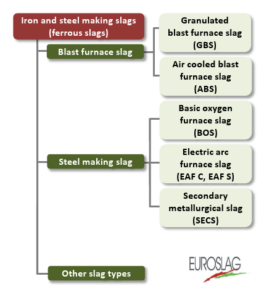Ferrous Slag – general information
Iron and steelmaking slags (ferrous slags) are co-products of the iron and steel making industry. They are non-metallic rock-like materials which are produced together with the metallic products of these processes.
Depending on the iron and steel production process different slag types can be manufactured. Blast furnace slag is made during the melting and reduction of iron ore in a blast furnace. Steel making slag (also: steel slag) is produced during the conversion of hot metal to crude steel in a basic oxygen furnace or during the melting of scrap in an electric arc furnace. If the crude steel undergoes further secondary steelmaking processes, different kinds of secondary metallurgical slags are formed. Additional slag types (e.g., de-sulphurisation slag) are formed during diverse supplementary metallurgical processes like de-sulphuristaion of hot metal.
In total, the following slag families can be identified in Europe today:
- blast furnace slag - air-cooled (ABS) or granulated (GBS)
- basic oxygen furnace slag (BOS)
- electric arc furnace slag - from carbon (EAF C) or stainless/high alloy steel production (EAF S)
- secondary metallurgical slag, e.g., ladle furnace slag (SECS)
- other slags, e.g. de-sulphurisation slag
Through careful selection of raw materials, maintaining a suitable process route, tightly controlled manufacturing procedures, appropriate cooling treatments a range of high quality construction, agricultural and other slag products are formed for use in large number of important applications.

